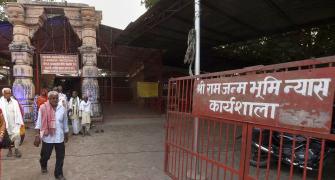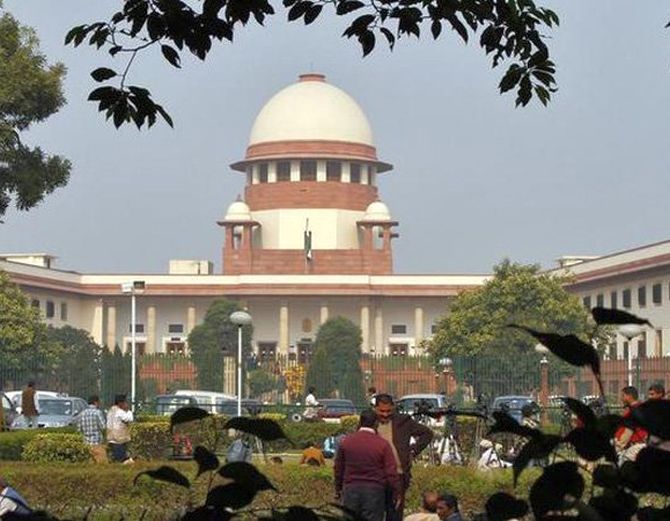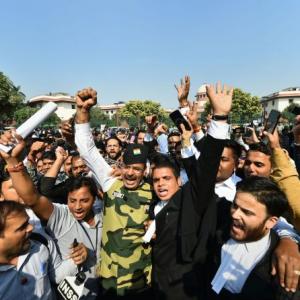'The verdict must be seen as something more; as a historical balm, a moral restitution and the deliverance of justice to a people wronged,' argues Vivek Gumaste.

The Ram Janambhoomi-Babri Masjid title dispute was paradoxically both: A byzantine, intricate conundrum that seemingly defied resolution, and a mother of all non-issues from a different viewpoint.
With historical understanding, empathy and a little magnanimity, this conflict could have been easily settled in post-1947 Independent India, but was intentionally hyped to exacerbate the festering wound of a community.
Consequently it came to represent a malicious ideological provocation that exploited the tenets of modern jurisprudence to obfuscate a logical, historical and civilisation truth; and a nuanced attempt to subtly perpetuate into modernity, under the guise of secularism, a defunct Islamic hegemony by giving validity to a crass medieval act of symbolic domination, namely, the building of a mosque over a site believed to be the birthplace of Hinduism's most revered deity, Shri Ram.
Thankfully, the Supreme Court put an end to this issue on November 9, 2019, nearly 500 years after the initial act of infamy.
In a unanimous verdict, a five-judge Constitution Bench decreed that 'suit 5 has been held to be maintainable at the behest of the first plaintiff (the deity of Lord Ram) who is a juristic person', thereby paving the way for the construction of a Ram Mandir at the hitherto disputed site.
But will this legal closure bring about a socio-political closure to this centuries-old contentious problem?
Will this landmark decision be the crucial first step in the larger process of Hindu-Muslim integration by breaking down the barriers of distrust and animosity, so vital for the unity and growth of modern India?
And will it herald the beginning of a new harmonious chapter in the troubled narrative of Hindu-Muslim discord?
By this verdict, the Supreme Court has done its part. It is now up to the Hindus and Muslims along with the political and intellectual leadership of the country to capitalise on this breakthrough.
For this to happen, there must be an unequivocal acceptance of the verdict, with no ifs and buts.
The essence of a democracy is the ability of its citizens to accept contrary verdicts with respect, grace and magnanimity. Irresponsible, knee-jerk partisan criticisms only dilute the spirit of democracy and serve to undermine the role of key institutions like the judiciary.
Sane sections of the Muslim community have responded with good sense. The Sunni Waqf Board, the Jama Masjid's Shahi Imam, and Shia cleric Maulana Kalbe Jawad -- all have unhesitatingly accepted the verdict and have counselled the community not to prolong the strife by repeated legal challenges.
Unfortunately, there have been a few voices of acrimonious dissent from Muslims and India's liberal lobby that could fuel unwanted dissent in the community.
M R Shamsad, advocate for Iqbal Ansari, one of the litigants in the case, writing an opinion piece (external link) in the Hindustan Times, categorically stated: 'Finally, in this case, Rule of Law has been defeated; majoritarianism and faith of one religion has prevailed.'
Retired Supreme Court judge A K Ganguly remarked (external link): 'The Constitution gives the right to everyone and justice has to be given to everyone but in this case justice has not been done to minorities.'
To claim that a Supreme Court verdict defeats the 'rule of law' is an incendiary, irresponsible statement that borders on contempt. And to use terms like majoritarianism and minorities is to forget the basic premise of the law.
These statements become all the more shocking and unacceptable when they emanate from judicial experts.
The credibility of the Supreme Court cannot be based on the quantum of minority-centric verdicts that it doles out; neither can an anti-majority stance be an index of its fairness.
To view judicial verdicts through the prism of minority versus majority is a dangerous, destructive trend that makes mockery of the basic concept of justice and invites chaos and confrontation; it does not make for a stable democracy.
Lady Justice, one must remember, stands blindfolded balancing a scale in her hands oblivious to the identity of the plaintiff and defendant.
Fully conscious of the sensitive nature of the issue and to abort such baseless charges, the Supreme Court prefaced its judgment by emphasising the non-partisan underpinning of its judicial verdict, stating:
'The law must stand apart from political contestations over history, ideology and religion.'
'The Constitution does not make a distinction between the faith and belief of one religion and another.'
'The court does not decide title on the basis of faith or belief, but on the basis of evidence.'
So to claim that this is a verdict based on faith is misleading, erroneous and subversive; a subtle attempt to devalue the merit of the pronouncement.
Faizan Mustafa, vice-chancellor, NALSAR University of Law, and Aymen Mohammed, a research scholar, writing in the Indian Express bluntly declared (external link): 'The judgment will be remembered for the victory of faith over the rule of law as the Supreme Court considered religious beliefs even in deciding a property dispute, and despite conceding that faith cannot confer title, it still went ahead to give property to worshippers on the basis of faith. In brief, it is the red-letter day for the Constitutional right to religion, but a setback to property law and a setback to evidence law with differential burden of proof being demanded from different parties.'
Again, this is a flippant conclusion triggered more by peeve rather than a rationale appraisal. The Supreme Court verdict was a meticulously parsed judgment that included a marathon hearing of 40 days and a detailed examination of historical data and archeological findings; the written report itself spanned 1,045 pages.
Criminal trials require evidence beyond a reasonable doubt. But in civil trials, evidence is required only by preponderance of the evidence and this is the principle that the Supreme Court applied to this challenging case strapped by the paucity of hard proof. The following excerpts clearly outline the legal basis:
'On the balance of probabilities, there is clear evidence to indicate that the worship by the Hindus in the outer courtyard continued unimpeded in spite of the setting up of a grille-brick wall in 1857. Their possession of the outer courtyard stands established together with the incidents attaching to their control over it.'
'As regards the inner courtyard, there is evidence on a preponderance of probabilities to establish worship by the Hindus prior to the annexation of Oudh by the British in 1857. The Muslims have offered no evidence to indicate that they were in exclusive possession of the inner structure prior to 1857 since the date of the construction in the sixteenth century.'
'Suit 5 has been held to be maintainable at the behest of the first plaintiff (the deity of Lord Ram) who is a juristic person. The third plaintiff has been held to be entitled to represent the first plaintiff.'
So, let us be clear about one thing: This was not a verdict of faith, but a sound legal judgment that conformed to the principles of modern jurisprudence.
With regard to the demolition of the mosque, when viewed in isolation and from the narrow perspective of the government of current times, it may be considered as a serious violation of the law. However, when juxtaposed against the backdrop of the wider Ayodhya controversy the criminality of the act becomes hard to classify; it was more of a symbolic remonstration.
The Ayodhya conflict was not a mere title dispute. It symbolised something much more; a protest against the hundreds of other temples destroyed, the millions of Hindus killed or forcibly converted -- in short it was a stance against the brutalisation of a civilisation.
More importantly, in modern India, it had come to represent the vulnerability of Hindu in Nehru's India: the pathetic inability of Hindus to build a temple to their most revered God in the land where they constituted 80% of the population under a supposedly secular regime.
Accordingly, the verdict must be seen as something more; as a historical balm, a moral restitution and the deliverance of justice to a people wronged.
Therefore, calls by traditional Hindutva baiters to prosecute those responsible for the demolition of the mosque on December 6, 1992, can only be termed as a myopic, immature and petty demand that may prove counterproductive by nullifying the overall gains of the verdict and prolong the controversy.
For Indian Muslims this verdict must serve as a nodal point to effect a change in mindset; a moment that engenders deep introspection leading to the acknowledgment (not responsibility) of the misdeeds of Islamic rulers of yore.
This becomes all the more imperative because by their strident defense of the Babri Masjid, some Indian Muslims have inadvertently identified themselves with the atrocities of past Muslim rulers
In conclusion, the Supreme Court was not swayed by majoritarianism. The verdict was not based on faith, but firmly grounded in the principles of jurisprudence.
For a full and final closure -- legal, political and social -- we need to accept this verdict unequivocally and wholeheartedly with no caveats; the criminal case must be allowed to lapse.
US-based academic and political commentator Vivek Gumaste is the author of My India: Musings of a Patriot.










